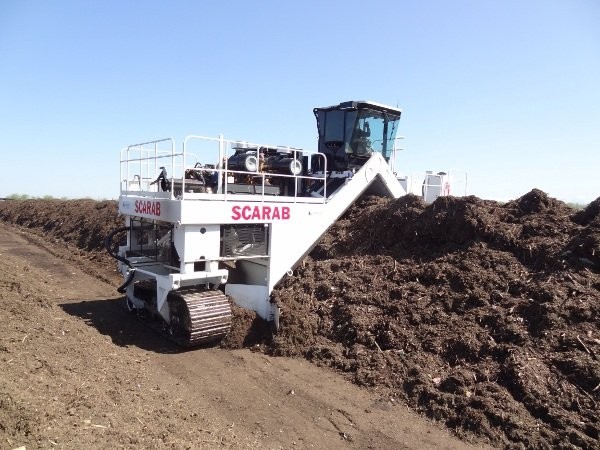It's in the drive
Belt-driven turners from Scarab are making a big difference at Harvest Power’s Tulare compost site

by Keith Barker
Harvest Power California, LLC’s site in Tulare, formerly known as Tulare County Compost and Biomass Inc., provides the region’s robust agricultural community with top quality compost, mulch products and custom blending to customer specifications.
The facility purchased their first Scarab compost turner over 15 years ago, and it is still in operation today. At the end of last year though, John Jones who is the site manager at Tulare, and who has worked at the Tulare site since 1996, felt a new model was in order.
“We do about 85,000 tonnes annually of organic waste materials from the area, and have plans to grow,” says Jones. “Our first Scarab turner we bought in 1996, was a 1994 model,” he says. “When we first bought the ‘94, it was the greatest thing since sliced bread, compared to the tow-behind model we had been using. It allowed us to get our rows significantly bigger. It was 18-feet wide by about seven feet tall. Compared to the old tow-behind which was about four feet wide, it made a big difference and was incredibly more efficient.”
In March of 2012, Harvest purchased a new Scarab turner for the Tulare facility, through Michael Clarke of Resource Machinery & Engineering out of Ventura, California. The new machine features a 20-foot wide tunnel at the base, is 10-foot wide at the top, and uses a 700-hp Cat engine.
“This is the biggest turner I’ve ever seen,” says Jones. “The wonderful thing about this new Scarab is that we are able to get close to 40 percent more material in our windrows, compared to our previous unit.”
A major difference between the new Scarab model and the older units is that the new machine uses a belt drive as opposed to a hydraulic drive. According to Scarab, belt drives transfer over 97 percent of available horsepower to the drum, compared to about 65 percent for a hydraulically-driven drum.
“You can’t believe the difference in fuel savings,” Jones says. “We’re seeing about 25 to 35 percent savings per day. It achieves the fuel savings because it is just incredibly fast through the windrow. What used to take 20 minutes to get through a windrow, now takes seven or eight minutes.”
“We think we’ll see about a three-year payback on the unit, from fuel and maintenance savings,” he adds.
Other key features on their latest belt-driven turners that Scarab says they’ve found operators really appreciate include their rubber lined tunnel, which helps contain dust. Plus, the engine has catwalks around it for easy access and maintenance. Scarab turners also use an auger style drum that completely aerates the pile, to the bottom, and cabs are built with panoramic views and utilize cameras for safety and productivity.
“The cameras in the cab help operators keep track of where they’re at in the windrow,” says Jones. “We have one in the front and a camera at the back, with a monitor in the cab. It’s excellent from a safety perspective as well as a production perspective.”
Additionally, over-sized components on these turners reduce issues of over heating and also help with their longevity. According to Scarab, their turners commonly last at least 20 years, when cared for and maintained properly.
“There are still several of our machines from the early 70’s that are being used every day,” says Britt Reid, Scarab’s Production Manager. “Our machines look rugged because they are built to last in rugged conditions.”



